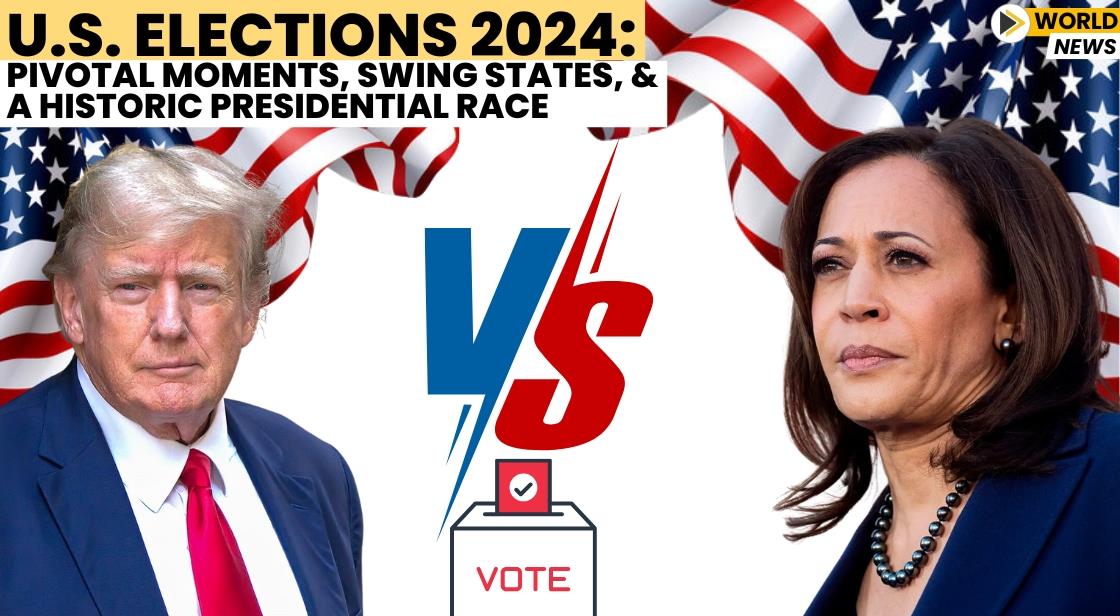U.S. Elections 2024: Pivotal Moments, Swing States, and a Historic Presidential Race

News Synopsis
The 2024 U.S. Presidential Election, set for November 5, is already shaping up to be one of the most intriguing and critical elections in recent history. As one of the oldest democracies in the world, the United States is witnessing unprecedented developments in its political landscape, including an assassination attempt on former President Donald Trump, President Joe Biden’s unexpected exit from the race, and even candidates offering cash incentives to boost voter turnout. With tight races predicted across the nation, each state and demographic has its unique dynamics, making this one of the most unpredictable elections ever.
How the U.S. President is Elected?
The U.S. election process is unique and complex, with approximately 240 million citizens eligible to vote in the 2024 election. However, the president is not chosen based solely on popular votes but through the Electoral College. To secure the presidency, a candidate must win the majority of the 538 Electoral College votes spread across the 50 states, needing at least 270 votes to claim victory.
Each state is assigned a certain number of electors based on its population, as measured by the census. For example, Alaska has three electoral votes, while populous California holds 54. When Americans cast their ballots, they are effectively voting for a slate of electors pledged to their preferred candidate. In most states, except Maine and Nebraska, the candidate with the majority of the popular vote claims all the state’s electoral votes.
Electoral College Dynamics in 2024
This year, the Electoral College could see pivotal shifts due to high voter engagement and tight competition in critical swing states. If Kamala Harris secures the popular vote in a state like Minnesota with 10 electoral votes, she would claim all those votes, underscoring how vital each state's support is in such a competitive election.
Biden’s Exit Shakes Up the Race
President Joe Biden's withdrawal from the presidential race in July 2024 came as a surprise and shifted the entire political landscape. This decision, influenced by waning public trust and a difficult debate with Donald Trump, marks a rare instance in U.S. history, as only eight candidates have ever withdrawn from a presidential race. His exit brings to an end a long political career, marked by his previous role as vice president under Barack Obama and his time as the 46th president of the United States.
Kamala Harris Enters the Race
With Biden stepping down Vice President Kamala Harris stepped in as the Democratic candidate, providing new momentum for the party. Polls show Harris has garnered substantial support, attracting numerous endorsements and fundraising contributions. Despite Trump's sustained popularity and continued campaign efforts, Harris has gained ground, particularly among progressive voters and key demographic groups. Trump, however, counters by asserting that Harris embodies the political pitfalls he associated with Biden, drawing endorsements from influential figures, including Elon Musk.
Swing States in Focus: The Deciding Factor
Swing states are again poised to play a decisive role in the election outcome, particularly Arizona, Georgia, Michigan, Nevada, North Carolina, Pennsylvania, and Wisconsin. These states, pivotal in the last two elections, are closely contested in 2024, with each party aiming to sway their significant Electoral College votes.
The Unique Case of Georgia
Georgia has garnered particular attention this election cycle as Trump faces legal charges related to alleged election interference in the state. This swing state’s outcome could influence national political discussions and have implications for Trump’s overall campaign.
Other Crucial Swing States
In 2020, Arizona swung Democratic for the first time in decades, and Democrats are keen to retain it this cycle. Michigan and Wisconsin have a history of tight races and were instrumental in the last two elections. Nevada, a historically blue state, shows a potential shift toward the Republicans in 2024, while North Carolina, previously won by Trump, has emerged as a “toss-up” state due to shifting dynamics since Harris entered the race.
Demographic Diversity and Key Issues in the 2024 Election
The 2024 U.S. election will witness a highly diverse electorate, with 40.8 million eligible young voters aged 18-27, including 8.3 million new voters. Approximately 45% of Gen Z voters identify as people of color, highlighting the growing multicultural presence in the electorate. Furthermore, the U.S. population comprises 47.9 million Black Americans, over 62 million Latin Americans, and nearly 5 million Indian Americans, contributing to a diverse demographic landscape that may influence the election outcome.
Pressing Issues and Voter Demands
Amid this diversity, major issues like economic stability, abortion rights, and immigration policy continue to dominate the election discourse. Each demographic has unique concerns and priorities, adding layers to the already complex electoral environment. For instance, Latin American communities may prioritize immigration reform, while young voters express significant interest in climate change and social justice issues. As these topics vary across states and demographics, the 2024 election is anticipated to not only affect the nation but resonate globally.
Conclusion:
As the U.S. gears up for one of its most pivotal elections on November 5, 2024, the landscape is charged with significant narratives and unprecedented dynamics. President Biden’s unexpected withdrawal, Kamala Harris’s surge as the Democratic candidate, and close contests in key swing states underscore the critical nature of this election. With a diverse electorate and pressing issues at the forefront, the 2024 election promises to shape not only the future of the United States but also influence global discourse on democracy, governance, and socio-political priorities.









